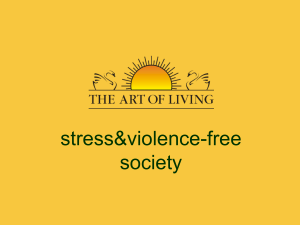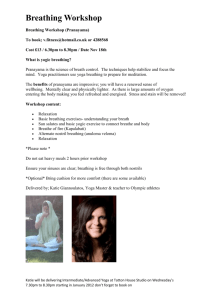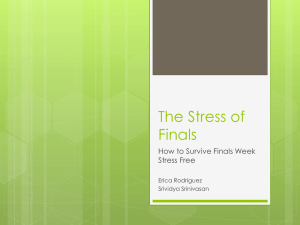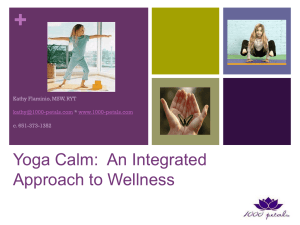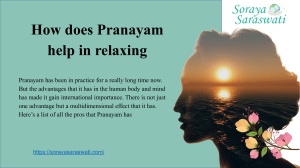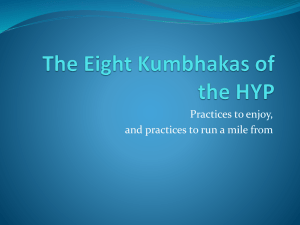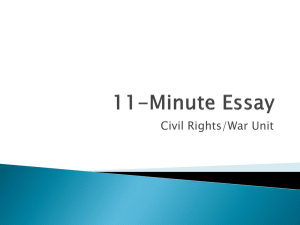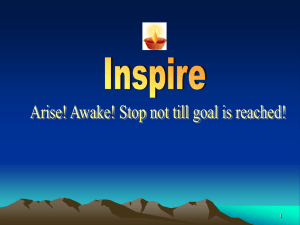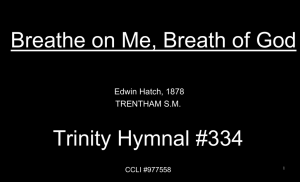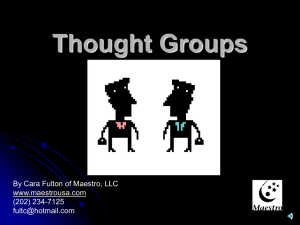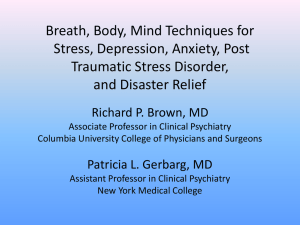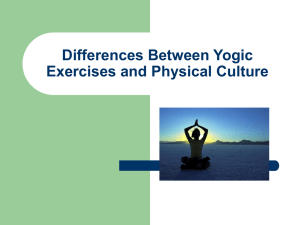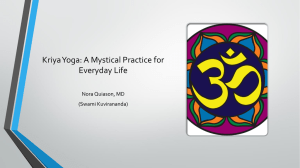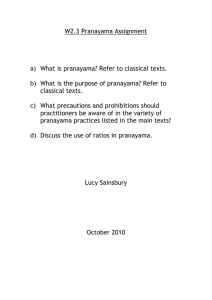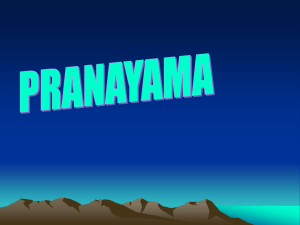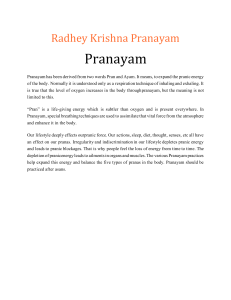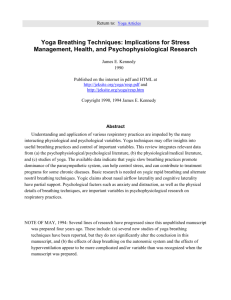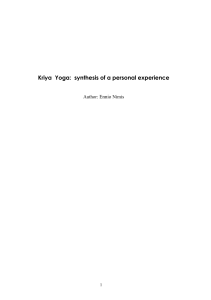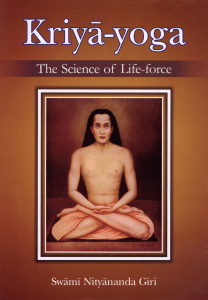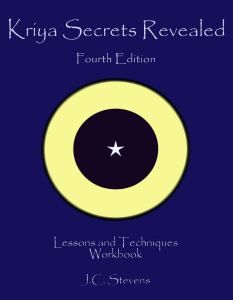Effect of Sudarshan Kriya Yoga and Pranayam (SKY&P)
advertisement
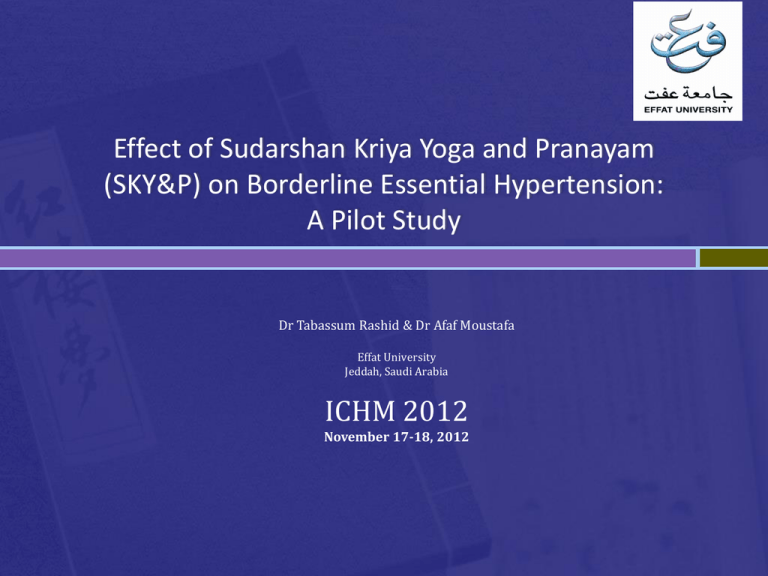
Effect of Sudarshan Kriya Yoga and Pranayam (SKY&P) on Borderline Essential Hypertension: A Pilot Study Dr Tabassum Rashid & Dr Afaf Moustafa Effat University Jeddah, Saudi Arabia ICHM 2012 November 17-18, 2012 “When the Breath wanders, the mind is unsteady, but when the Breath is still, so is the mind still." - Hatha Yoga Pradipika Evaluating the effects of SKY&P- a breathing and meditation intervention, on levels of BP, oxygen in blood, PF, and Positive Affect and Negative Affect among individuals with borderline essential hypertension Project period: 2011-2012 Principal Investigator: Tabassum Rashid Ph D Co- Investigator: Afaf Moustafa MD Intro Purpose Method: -Sample -Procedure -Data Analysis Results Discussion & Conclusion Limitations and Scope Numerous psychological researches report significantly higher scores on measures of : Neuroticism Anxiety Depression General psychological distress/ stress,etc The word Yoga comes from the Sanskrit word “Yuj” that means to yoke, join or unite Practiced for centuries, it entails amalgamation of all aspects of the individual – body, mind and soul – to achieve a happy, balanced and healthy life Currently yoga is being studied as a science--practical, methodical, and systematic The Art of Yoga Breathing: Pranayama Pranayam: The ancient science of breath meaning both “control of energy” and “experience of energy” (Sovik, 2000) “Tasmin Sati Svasa prasvasayorgativicchedah Pranayamah”—Regulation of breath or the control of Prana is the stoppage of inhalation and exhalation, which follows after securing that steadiness of posture or seat, Asana…Patanjali Yoga Sutras, Chapter II-49 The object of Pranayama practice is to emphasize the Inhalation, the Exhalation, or retention of the breath. Emphasis on the Inhalation is called Puraka Pranayama, whereas, Rechaka Pranayama refers to a form of Pranayama in which the Exhalation is lengthened while the Inhalation remains free. “Sudarshan Kriya incorporates specific natural rhythms of the breath which harmonize the body, mind and emotions. This unique breathing technique eliminates stress, fatigue and negative emotions such as anger, frustration and depression, leaving you calm yet energized, focused yet relaxed”. Sudarshan: Su stands for “proper” and darshan means “vision” Kriya: a yogic practice meant to purify the body Sri Sri Ravi Shankar : Art of living Research indicates that Sudarshan Kriya has significant effects and outcomes on several physical and psychological disorders: Reduces levels of stress by reducing the stress hormone ‘cortisol’ Boosts immune system Increases anti-oxidant protection: Enzymatic activities and gene expression of specific antioxidant systems have been reported to be increased in SK practitioners…lifespan of the lymphocytes were increased which correlated with an increase in the expression of anti-cell death genes and prosurvival genes. This study suggests that SK may exert its effects on various physiological systems through changes in gene regulation. (Sharma,2008). SKY & brain functioning…EEG analysis shows better information processing. Reduces anxiety and depression from mild, moderate to severe. A pilot study investigated the anti-depressant efficacy of Sudarshan Kriya and accompanying breathing practices (SK&P) in 15 dysthymic and 15 melancholic (major) depression patients whose sole treatment was SK&P, and showed a significant improvement (Janakiramah, et al.,2000) Post-traumatic stress disorder (Descilo, T., et al.,2009)on Sunami survivors; on Hurricane Katrina survivors (Garberg & Brown, 2005) Cognitive emotion regulation - sustained modulation of electrical brain potentials (Gootjes, L., Franken, I.H.A., and Van Strien, J.W. (2011) Sample Twenty five borderline hypertensive female patients (30-50yrs)registered in the outpatient clinic of a private women’s university were selected for the study. The participants were not on any kind of prescribed medications either for hypertension or any other physical or psychological ailment. ‘Saga of small sample’ (SSS!) Procedure The proposal was approved by the Effat University Research Committee, and permission to use human subjects was obtained from the Research Ethics Committee An informed written consent was obtained from the participants The initial sample size comprised of 13 participants in the experimental group and 12 in the control group However, 3 participants from the experimental group dropped out in the very beginning and 3 more stopped during the first 5-6 weeks of intervention, reducing the sample to problematically low. The experimental group was trained in Pranayamas and Cyclic Breathing of SKY by an Art of Living (AOL)licensed instructor in a 5-day intensive program Participants followed up practicing on all week days for an hour in the Psychology Lab at Effat University On weekends they were advised to practice at home and keep a log Participants were advised NOT to make any changes in their life style: diet, exercise, etc the practice continued for twelve weeks, with a bi-monthly follow up with the instructor Various parameters including Blood pressure were recorded before interventions, weekly during the trials, and at the end of the experimental trials Ujjayi breath also called ‘ocean breath’, ‘victory breath’/ pranayam yogic three-part breathing (three cycles, once with hands on waist, hands at chest level with elbows extended to the side, and arms up and hands touching back shoulders, biceps by the ears) bastrika: (also called bellows breath, three repetitions), Om chanting (three repetitions) and Sudarshan Kriya: a special yogic package involving rhythmic breathing process of variant rhythms ranging from slow and calming to rapid and stimulating All four of these breathing exercises or practices are part of yogic tradition, and Sri Sri Ravi Shankar has modified them slightly or substantially. Using IBM SPSS-20 software, the independent samples t-test was used to examine the differences among the experimental and control groups The paired samples t-test was administered to measure the differences, if any, pre and post intervention phases in the experimental group, as well as control group, and also to measure the differences in each participants pre and post intervention means of both systolic and diastolic blood pressure. The post intervention systolic blood pressure of participants in the experimental group (M = 89, SD = 5.71) was lower than that of the participants in the control group (M = 136.44, SD = 11.46).The test was significant, t(15) = -2.46, p = .05. A paired-samples t test was used to see the difference within experimental group pre and post intervention on both systolic and diastolic blood pressure. The results indicated that the mean for post intervention (M = 6.13, SD = 3.88) was significantly lower than the mean for post intervention (M = 10, SD = 7.29), t(7) = 4.48, p < .05. Results indicated a decrease in the means of both systolic and diastolic blood pressure of participants (P<0.05), when calculated separately! Qualitative data to substantiate the findings Interviews- Recordings-Transcripts- Content Analysis Blood pressure levels came down to normal and stayed within normal range even after the trials stopped Stress relieved Felt more energetic Better performance Positive moods Less irritability This pilot study on a small sample has indicated that SKY& P may be beneficial in borderline essential hypertension, however, further systematic studies using larger samples and various locations are strongly recommended to confirm these results. Implications: Sudharshan Kriya & Pranayam could be a cost effective treatment for hypertension No side effects No intervention With additional health benefits Easy to learn and practice ??????????? Limitations: Type of sample : Internal validity? Small sample : External Validity? Limited generazibilty! Questions or Comments?
